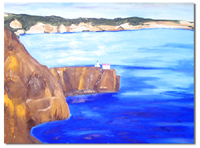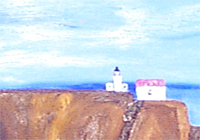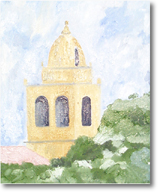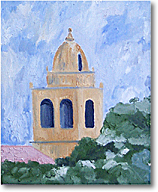By far the best thing you can do to make great photos of your artwork is to carefully choose your light.
How do you choose your light?!?? you ask. Simply override the automatic, flash-everything-to-a-nice-pasty-white function on your camera. Shoot outside on an overcast day or utilizing indirect light, i.e. shade.
The best light for photographing artwork is overcast or indirect natural light. Resist the urge to resort to flash unless you absolutely have to (if the day is really dark and dreary, your images may pick up a blue cast). Dig out your camera manual if you have to and force your flash to not fire. This will ensure your beautiful paintings will not be hidden underneath a layer of distracting glare.
 Flash Alert |
 Detail of Flashed Photo |

Sometimes you may want to try adding extra light. Your situation - your art media, your camera, your weather - may make it so that pictures shot with a flash are more accurate.
In the following example, the flashed picture is not too far off from the original. The non-flashed image is a bit oversaturated but still has more color and detail than the slightly washed-out image. Either of these images, with a little help from Photoshop, can be made more accurate. Without going digital, I would opt for the richer, more colorful image than the flashed image. You will especially note the difference if you click on each image to see the enlargement.
 Flashed |
 Natural Light |
1) How to Photograph Paintings - Introduction
2) Turn Off Your Flash
3) Up Against the Wall
4) Dealing with Frames
5) Dealing with Glass
6) Digital Fixing